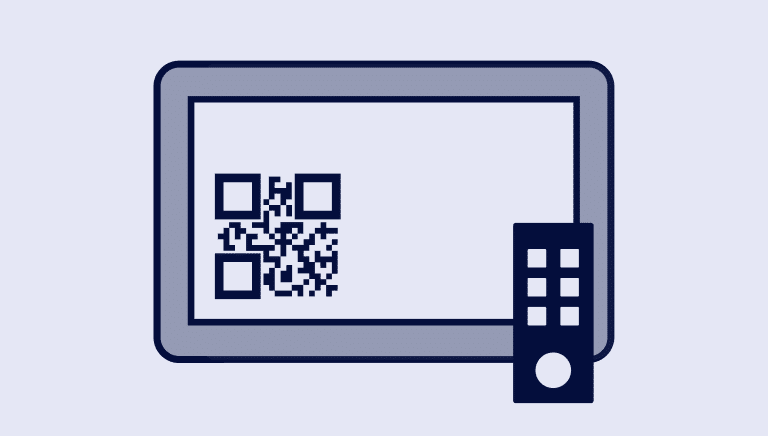What was once a fringe use case, mainly popular in Asia, has become the new normal for marketers in North America and across the globe. Quick response (QR) code usage exploded during the pandemic and beyond as a contactless and easy way to drive engagement from users with menus, and quickly expanded to promotions and app downloads.
In the years since restaurants first deployed QR codes to replace the need for physical menus, the chessboard-like grids now adorn signs, mailers, product packaging, badges, stickers, napkins, and even individual receipts.
And, thanks to a viral Super Bowl ad, you’re increasingly seeing them on your TV. These are all interesting use cases to bring offline users to your digital properties, leveraging the ubiquity of smartphones in nearly every pocket as a way to bridge the “phy-gital” divide.
QR code tactics are easy to identify. Examples to emulate are all around us, but they say that, “tactics without strategy is the noise before defeat.” Throwing money at QR campaigns is like making use of a shiny new toy, and perhaps that expands the reach of your marketing, but just utilizing QR codes doesn’t necessarily move the needle for your business.
However, QR codes can do quite a lot to transform and accelerate the strength of your digital connection to consumers when combined with a robust mobile growth strategy. And for many industries, offline audiences can be a huge source for growth, representing a larger addressable market than existing desktop or mobile traffic.
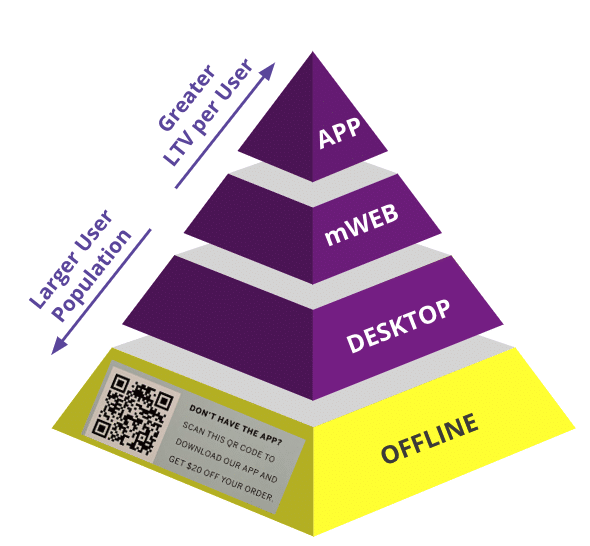
In order to have this maximum benefit, platforms must find the right balance of intent-based marketing and think about how digital engagement fits into their broader performance indicators, like engagement, retention, or lifetime value (LTV).
Optimizing your QR code strategy
As in other channels, to win this game, you must match the placement of a QR code campaign with the intent of the users who see it. There is no one-size-fits-all message. Brand awareness is often aimed at wide audiences for building the top-of-funnel pipeline. Whereas highly targeted and personalized calls to action should be deployed in a one-on-one pathway, directed specifically at users who have demonstrated high intent.
It’s important to wield QR code campaigns in a portfolio approach, aiming different messaging at different audience segments. Whether you’re promoting app-only features, driving app downloads, or offering a financial incentive, customers will respond to different calls to action (CTAs) depending on the channel they’re in—and where they are in the customer lifecycle.
Using intent-based strategies
An effective portfolio will have a mix of more general, ongoing one-to-many campaigns as well as personalized one-to-one campaigns. And plenty of examples exist between those ends of the spectrum.
An efficient strategy is to match the volume or specificity of the campaign with the intent of the user. A simple framework is to break users (and campaigns) into three buckets:
1. Passive campaigns (low intent)

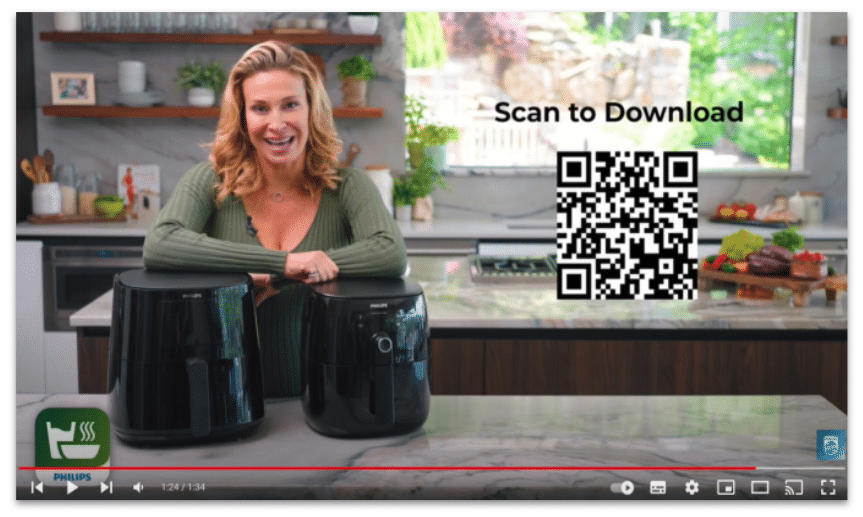
Most big brands invest in general awareness campaigns already, so adding a QR code to real estate they’re already paying for adds an additional layer of return on that investment. Depending on the industry, a brand might want to take mobile users directly to app stores to download their app and begin onboarding for their platform. Or they can take users to a mobile splash page and leverage other tools like smart banners to draw them further down the acquisition funnel.
These campaigns can be put on billboards, in print in periodicals, or even on TV screens during commercials or as a sponsor during TV segments. These campaigns will have wide visibility, but low expected activation rates (click-through rate, or CTR). In time, users might be more adept at grabbing their phone and activating a code during the course of a fleeting TV spot, but with print mediums, users have time to see a code and decide when to activate it. Incentivising these CTAs will boost their activation rates, and by measuring their success holistically, brands can optimize their marketing efforts around new users acquired via QR codes.
2. Active campaigns (medium intent)
For even greater efficiency, QR codes can be leveraged on owned channels through physical or digital representation. This includes signs around a retail location or stickers and posters in areas where customers tend to aggregate or wait for service. Groups of users will see these codes, but are inherently more primed to use them as they are visiting the site as an active customer.
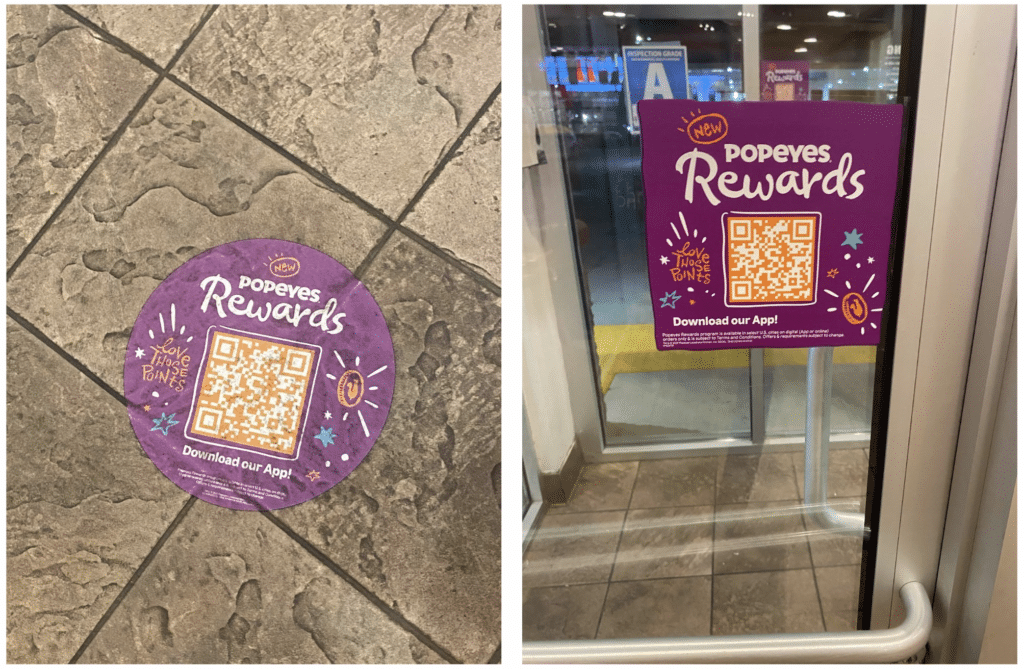
While these user groups are smaller, they are a higher-intent subset of the addressable market, so their engagement rate should be much higher. You’ll see more and more QR codes at brick-and-mortar locations for restaurant chains, clothing stores, and other retailers. The objective is to help migrate existing customers in the app, where they’ll be able to engage long after they’ve left the store.
3. Active campaigns (high intent)
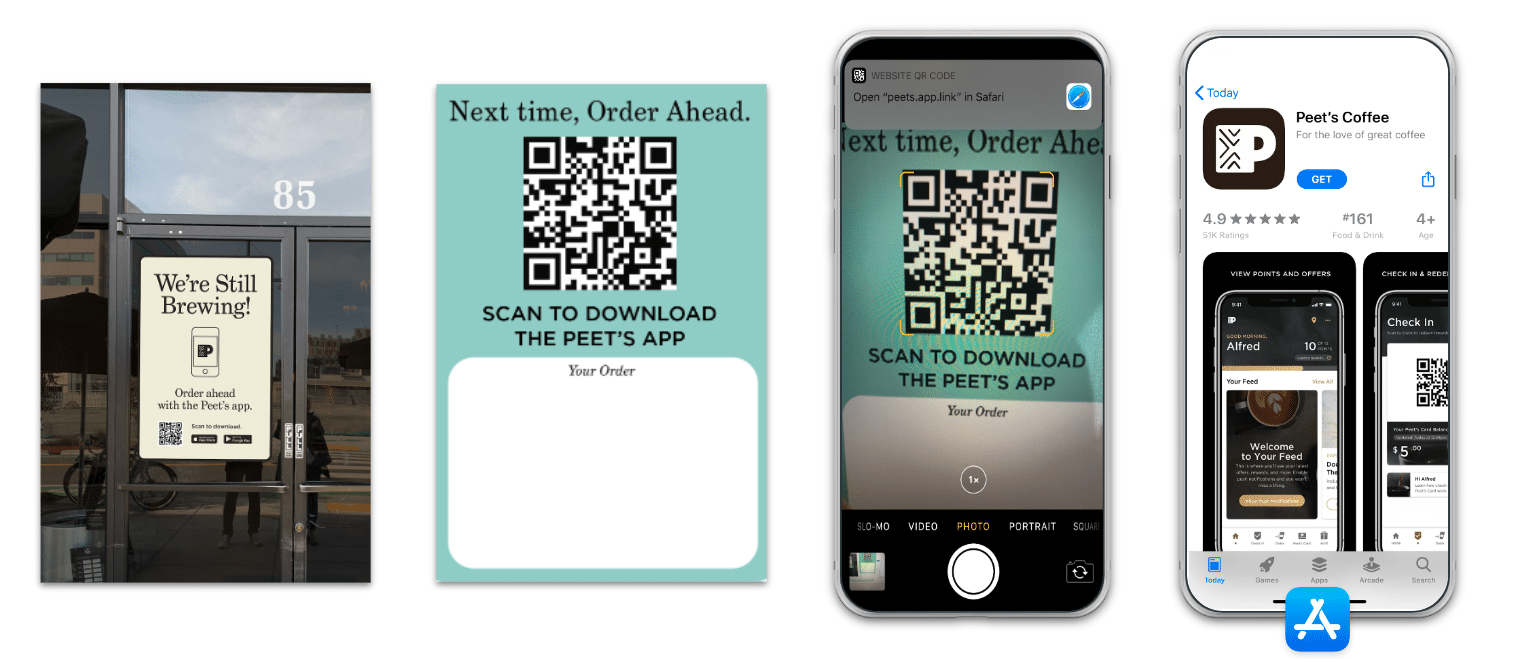
Offering a way to engage or drive app adoption among captive audiences is an effective strategy. Going further, brands might deploy QR codes in a one-to-one way by placing them on things that their customers take with them. Codes can be placed on takeaway bags, handouts, fliers, product packaging, inserts in delivered packages, or on a customer receipt. In some cases, the QR code could be generated dynamically, specifically delivered for that particular end user. A deferred deep link might help activate a new user account or ensure a new shopper is enrolled in a loyalty program and that the customer gets credit for their very first purchase.
Onboarding in-person customers to an app experience leapfrogs normal acquisition steps. Customers now have a direct pathway to engage with a brand and can do so in the easiest way—from the app on their phones. Brands then have a more loyal and engaged customer, one they can reach with deep links from a variety of customer relationship management (CRM) channels.
What happens after a user scans your QR code?
From the start, brands must decide where to send the user once a QR code is activated. To the app store or your mobile web site? Both routes can eventually lead to an app download, so whether it’s a single click to the app store or a two-step process with a splash page, the app install is still the primary goal.
And once again, there’s a decision to be made. Just downloading the app is a win, but a deferred deep linking experience that personalizes the first app open enables a better user experience. Otherwise, all users get the same first-time experience on a generic home screen, providing no personalization. For example, with a subtle change like the confirmation of a promotion code or content that is tailored to the user’s prior engagements, the first-time app open can boost user conversion, retention, and ultimately LTV.
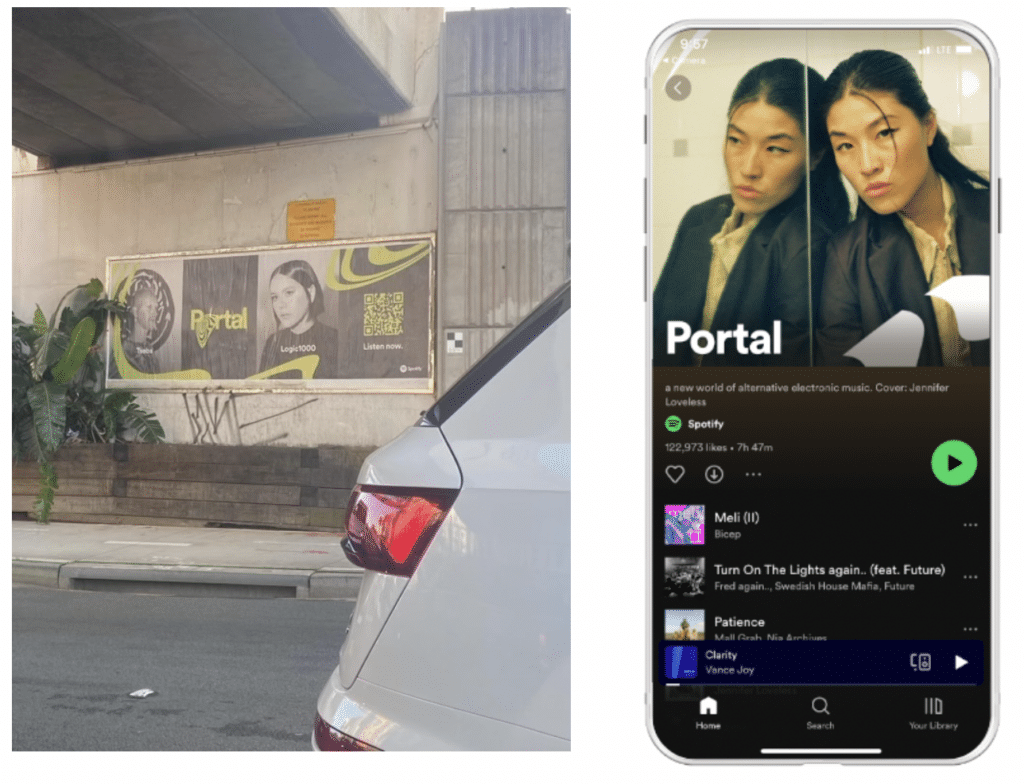
It’s understandable why many brands miss this personalization opportunity; it’s hard! But a mobile linking platform (MLP) like Branch enables deep linking to bring users to their desired content—even after downloading the app—to expedite onboarding flows and even auto-apply promotion codes. In a world where incentivization is used aggressively to win new users, these small UX boosts can give a huge advantage to brands that leverage deferred deep linking.
Real-time engagement
And let’s not forget that the “Q” in QR stands for “quick.” These codes not only bridge the offline-to-digital gap, they enable immediate digital engagement. Expect to see QR codes deployed throughout many different industries, especially the travel and entertainment sectors, as a way to engage in real time. Because apps allow for direct digital end-user engagement, expect more industries to leverage them comprehensively throughout the customer lifecycle. It’s a win-win for the platform and customer as these UX opportunities often allow end users to do more in less time than in an offline or asynchronous digital world.
In the travel industry, for example, apps allow for mobile check-ins, upgrades, and food service in advance of a trip, but also keyless hotel room entry and over-the-top (OTT) entertainment during the trip. Not to mention the usual account management functions that could vastly reduce the need for expensive customer service call centers.
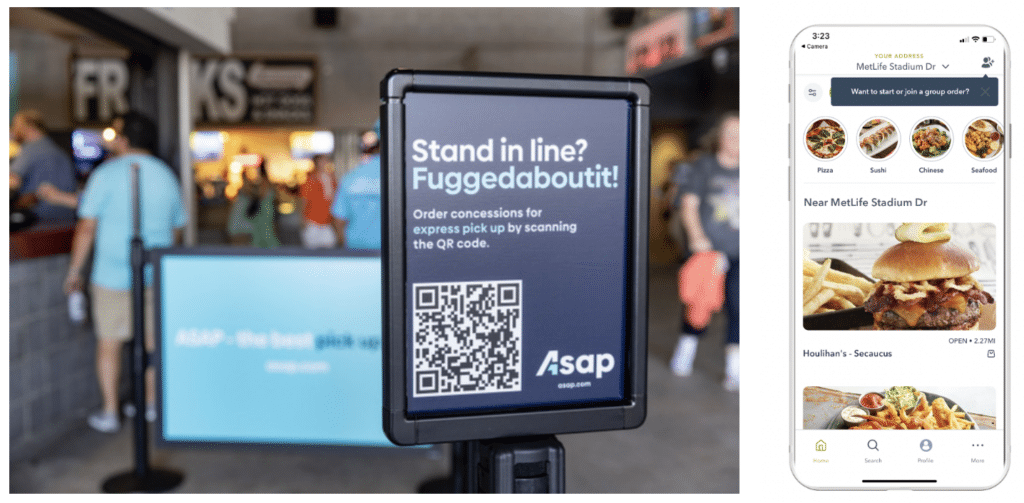
The benefits of a mobile linking platform
Greater app adoption from larger, offline addressable markets combined with the user experience benefits of real-time engagement is already a win-win justification for QR code deployment. But by leveraging a solution like Branch’s MLP for QR codes, marketers can easily connect the dots between offline activations and down-funnel events.
Did a TV or mailer campaign promoting 10% off a first in-app purchase drive enough new buyers, or was it the $10 discount that delivered greater ROI? Down-funnel attribution gives marketers quantifiable results from end to end. This data provides maximum visibility into the engagement that originated offline via QR codes.
Branch and QR codes
We’ll all start noticing QR codes with greater frequency on more and more offline channels. But some of this will be a wasted effort by brands until they think strategically about their deployment and holistically about their measurement. Thankfully, we’re here to help!
Learn more about how you can grow your business with Branch QR codes.






















